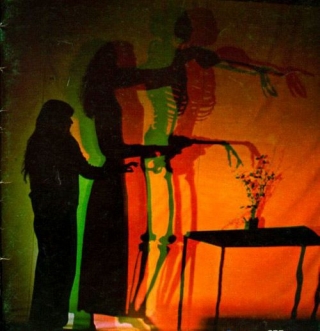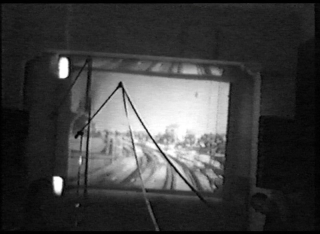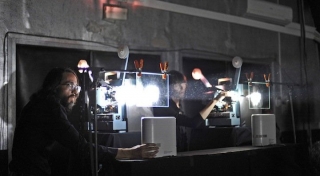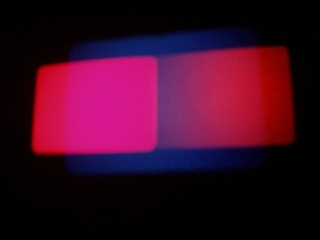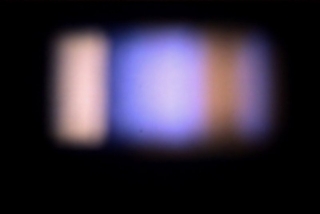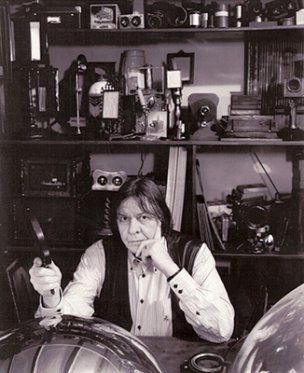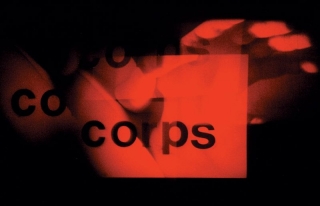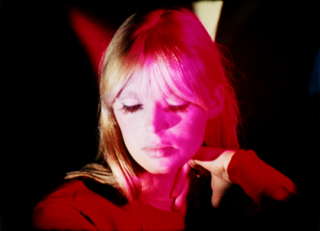Date: 10 September 2004 | Season: Expanded Cinema 2004 | Tags: Dortmund, Expanded Cinema
EXPANDED CINEMA: FILM ALS SPEKTAKEL, EREIGNIS UND PERFORMANCE
10 – 26 September 2004
Dortmund PhoenixHalle
From the 10th to the 26th of September hartware medien kunst verein in conjunction with medien_kunst_netz dortmund present the festival Expanded Cinema: Film als Spektakel, Ereignis und Performance (Expanded Cinema: Film as Spectacle, Event and Performance). The programme has been conceived by Mark Webber and is a survey of Expanded Cinema encompassing historical works from the 1960s to the present day. Many of the artist-filmmakers will appear in person and will be available for discussion with the audience after the performances.
»Expanded Cinema« is the term used to describe works that do not conform to the traditional single-screen cinema format. Expanded cinema is not a movement; it is a style of presentation that can be used for films or performances made for a wide variety of aesthetic, personal and political reasons. The only common link between them is that they do not adhere to the »standard« mode of presentation of a single, continuous film projected onto a screen in front of an audience. Projectors are often placed in the room with the audience (not hidden away in a booth at the back) and become part of the overall, participatory event.
The programme stresses the unique, ephemeral and temporal qualities of a finite film or performance that has a beginning, middle and end, and is, by its nature, a shared experience for the assembled audience. There will be no secondary documentation, re-interpretations, installations or static loops, each piece happens once only at a designated time. It presents only film-based, »living works« in their original formats, including multi-screen projections, film performances and expanded cinema events. There will be no use of video or digital technology, but the influence these works have had on the development of new media and gallery installations will be clearly evident.
10-12 September 2004
Participating Artists: Valie Export (Austria), Christian Lebrat (France), Werner Nekes, Jurgen Reble & Thomas Köner (Germany) Malcolm Le Grice, Guy Sherwin (UK), Sandra Gibson & Luis Recoder, Bruce McClure (USA). Plus Films By: Joost Rekveld (Netherlands), Gill Eatherley (UK), Morgan Fisher, Paul Sharits (USA).
17-19 September 2004
Participating Artists: Maria Klonaris & Katerina Thomadaki (Greece/France). Plus Films By: Fred Drummond, Gill Eatherley, Sally Potter, William Raban, James Scott, Chris Welsby (UK), Storm de Hirsch, Claes Oldenburg, Barbara Rubin, Carolee Schneemann, Paul Sharits, Andy Warhol (USA).
24-26 September 2004
Participating Artists: Giovanni Martedi (Italy/France), Anthony McCall (UK), Wilhelm Hein (Germany), William Raban (UK), Tony Conrad (USA). Plus Films By: Birgit Hein (Germany), Lis Rhodes (UK), Beverly Conrad (USA).
Presented by harware medien kunst verein & medien_kunst_netz dortmund
Curator: Mark Webber
Coordination & Press: Katrin Mundt
Technican: Uwe Gorski
Venue: Phoenixhalle, Hichofenstraße / Ecke Rombergstraße, Dortmund-Hörder, Germany.
In cooperation with dortmund-projet, LEG – landesentwicklungsgesellschaft NRW, Kulturbüro Stadt Dortmund.
Read more
Expanded Cinema: Film as Spectacle, Event and Performance presents an international survey of works that transcend the traditional modes of projection.
Film as Spectacle: Expanded Cinema can fill our field our vision as an environment of light-beams or with large, integrated multi-panel projections.
Film as Event: Expanded Cinema works are unique temporal experiences, different every time they are projected and distinct from film installations.
Film as Performance: Expanded Cinema often incorporates live performative actions of the artist-filmmaker, either behind the projector or in front of the screen.
DEFINING ‘EXPANDED CINEMA’
‘Expanded Cinema’ is the term used to describe works that do not conform to the traditional single-screen cinema format. Expanded cinema is not a movement; it is a format of presentation that can be used for films or performances made for a wide variety of aesthetic, personal and political reasons. The only common link between them is that they do not adhere to the ‘standard’ mode of presentation of a single, continuous film projected onto a screen in front of an audience. Projectors are often placed in the room with the audience (not hidden away in a booth at the back) and become part of the overall, participatory event.
Expanded cinema can widen our field of vision. With two (or more) projections side-by-side or vertically aligned, individually images may act in harmony, dialogue or counterpoint with each other. Real time may be measured against itself, exaggerated or contracted; abstraction can be further abstracted. Expanded cinema also explores the transience of the medium – with these works, no two projections are ever the same.
The work often questions the role of the spectator and sometimes what happens across the room is more important than what is on the screen. Expanded cinema can take place in the traditional theatre environment, but a flat, open room with no fixed seating offers filmmakers wider freedom to experiment with projection. Expanded cinema includes films that incorporate live performances, and even light pieces that do not use any film at all.
In his epochal book Expanded Cinema (Studio Vista, 1970), American media theorist Gene Youngblood defines the term in a different way, stating that “When we say expanded cinema we actually mean expanded consciousness”. His hypothesis concerns the moving image in a general utopian sense, is not limited to film technology, and discusses the expansion of cinematic possibilities that was made possible by the invention and integration of the then new technologies of video, computers and holograms at the end of the 1960s. Youngblood covers inter-media events and environments that present an ‘expanded field’ of visual or sensory stimulation.
The range of work that may be called ‘expanded cinema’ is extremely broad, encompassing the multi-media spectacles seen at expos and world fairs, along with the use of film in happenings, light shows, intermedia performances, gallery installations, public actions (which may reference cinema but use none of its technology) and absurdist events that attack the theatrical situation.
Expanded cinema and the projected image has recently been the focus of three major international exhibitions – Into the Light (Whitney Museum, New York, 2001), Future Cinema (ZKM Karlsruhe, 2002), X-Screen (MuMoK, Vienna, 2003) – which have taken significant steps to embrace expanded cinema within the historical framework of contemporary art. Each has importantly included the work of filmmakers from the avant-garde (film co-op) tradition with established visual artists from the art world. But as gallery-based exhibitions presenting continuous installations, or photo and text documentation, they have limited in their ability to demonstrate the vitality of expanded cinema as a performative and variable live event.
Expanded Cinema: Film as Spectacle, Event and Performance is an attempt to redress this imbalance, particularly concentrating on works which developed, more of less, within the tradition of avant-garde and formal filmmaking.
In that context, Expanded Cinema was in many ways an elaboration of the concept of ‘film as film’ pursued by the structural/materialist filmmakers of the 1960s and 70s. It extends their inquiry into the unique properties of the film strip, and the raw physicality of the medium, into the moment of projection.
This hands-on presentation of the work also takes the film avant-garde’s idea of a ‘personal cinema’ back to the home movie that is projected by the family member that shot the film. Performances of expanded cinema often require the presence of the artist-filmmaker, who must physically manipulate the projector in order to present the work completely. The machinery is not hidden away in a projection booth, as is usually the case at a public screening, but is located in the room alongside, or behind, the audience, where it can easily be seen.
Here, the projector, and very moment of projection, becomes analogous to the camera as a mechanism by which the work is physically created and reproduced. With such fundamental forms of cinema, not only the camera, but also the initial impulse or concept, the exposure of the film stock, the methods of printing and processing the film strip, the moment and style of projection, and also the discourse that is built up around the work, contributes to the overall construction of each piece.
With all these aspects vital to a total work, the act of filmmaking becomes extremely artisan. The filmmaker is usually involved with all stages of production and presentation, if not directly executing every phase themselves. Given these conditions it becomes essential to consider these works as having developed from a visual art tradition rather than the more industrialised cinematic approach, and as such there are more direct and visible links between these works and advances in fine art (from abstraction through minimalism and conceptual art), than in the most auteur or independent strains of commercial cinema.
Expanded cinema, like traditional painting and sculpture, is precarious and unstable. Projectors may be turned on at the wrong time to be immediately abandoned and restarted. They may drift out of sync, lamps can blow and films may break. These are rare occurrences, but they keep it real and act as a reminder of the medium and its transient conditions.
Just as old-fashioned, acoustic musical instruments sound warmer and more pleasurable than their digital equivalents, so film retains its unique qualities that make it a richer and more sensual medium than video or new technologies in the moving image. The reassuring clatter and whirr of a mechanical projector and the nerve-wracking moment of projection is a life affirming moment.
In the film underground of the 1960s, many artist-filmmakers began to experiment with different formats of projection, using multiple film projectors, or combining film projectors with other media, sometimes making cinematic shadow plays with only a simple light source. Such activity continues today, with many artists still making the aesthetic choice to use film instead of cheaper, more easily accessible video technology. One day (some believe this is coming soon) it will not be possible to see these works in their original form, with the guiding hands of their creators. Not only are the pioneering filmmakers getting old, but the technology of projectors and also film itself is in danger of becoming obsolete.
Back to top
Date: 10 September 2004 | Season: Expanded Cinema 2004 | Tags: Dortmund, Expanded Cinema
EXPANDED CINEMA: FILM ALS SPEKTAKEL, EREIGNIS UND PERFORMANCE
10 – 12 September 2004 (First Weekend)
Dortmund PhoenixHalle
The opening weekend is characterised by a diverse range of works that investigate the properties and use of colour in film and projected light, often using abstract imagery. The season will commence with an early two-screen film by Werner Nekes projected outside the gallery into the surrounding environment. Filmmaker and theorist Malcolm Le Grice will show a selection of his colour field films for up to eight projectors and Jurgen Reble will perform Alchemie (1992), using a mixture of chemical substances to irreversibly transform the composition of a film loop in real time.
Saturday features three young New York artists that recently participated in the Whitney Biennial. The afternoon begins with collaborative works for Super-8 and 16mm by Luis Recoder & Sandra Gibson present and later Bruce McClure performs with four specially adapted projectors. There will also be multi-screen films by Gill Eatherley, Joost Rekveld and Paul Sharits, and a performance by Christian Lebrat.
On Sunday afternoon, Werner Nekes will give a lecture/demonstration that illustrates pre-cinematic precedents of expanded cinema, followed by a special programme in which the screen is not only illuminated, but activated. Valie Export, Malcolm Le Grice, Werner Nekes and Guy Sherwin will present live performances of seminal film actions from the 60s & 70s in a programme that also features Morgan Fisher’s Projection Instructions (1976), which invites the projectionist to get in on the act.
Participating Artists: Valie Export (Austria), Christian Lebrat (France), Werner Nekes, Jurgen Reble & Thomas Köner (Germany) Malcolm Le Grice, Guy Sherwin (UK), Sandra Gibson & Luis Recoder, Bruce McClure (USA).
Plus Films By: Joost Rekveld (Netherlands), Gill Eatherley (UK), Morgan Fisher, Paul Sharits (USA).
Date: 10 September 2004 | Season: Expanded Cinema 2004 | Tags: Dortmund, Expanded Cinema
EXPANDED CINEMA: OPENING NIGHT
Friday 10 September 2004, at 8pm
Dortmund PhoenixHalle
Werner Nekes, Schnitte für ABABA, 1967, 11 min, mobile projection
A metrically edited film which animates nature and buildings through rapid changes in light. According to its original instructions, the film will projected outdoors onto the surrounding environment.
Malcolm Le Grice, Matrix, 1973, 18 min, 6 projector performance
Malcolm Le Grice, Blue Field Duration, 1972, 8 min, 2 screen film
Malcolm Le Grice, Threshold, 1972, 17 min, 3 projector performance
Malcolm Le Grice, Horror Film I, 1971, c.15 min, 3 projectors & live performance
As one of the core members of the London Film-Makers’ Co-operative, Le Grice established the idea that printing processing and projection were essential creative elements of filmmaking. His colour field films of the early 70s use rich, dynamic hues, which complement and contrast each other as the projectors are moved in predetermined sequences, creating constantly varied, durational ‘screen structures’.
Jürgen Reble & Thomas Köner, Alchemie, 1992, c.60 min, alchemical sound & film performance
By directly applying chemicals to the emulsion of a prepared film loop, Reble progressively decomposes and modifies the image, whilst Köner creates an electronic, aural counterpart using ambient sound. As the performance progresses, the elements are transformed into an abstract, iridescent unity.
Read more
EXPANDED CINEMA: OPENING NIGHT
Friday 10 September 2004, at 8pm
Dortmund PhoenixHalle
SCHNITTE FÜR ABABA
Werner Nekes, Germany, 1967, 16mm, colour, sound, 11 min, mobile projection
MATRIX
Malcolm Le Grice, UK, 1973, 16mm, colour, sound-on-tape, 18 min, 6 projector performance
BLUE FIELD DURATION
Malcolm Le Grice, UK, 1972, 16mm, colour, sound, 8 min, 2 screen film
THRESHOLD
Malcolm Le Grice, UK, 1972, 16mm, colour, sound, 17 min, 3 projector performance
HORROR FILM
Malcolm Le Grice, UK, 1971, 16mm, colour, sound-on-tape, c.15 min, 3 projectors & live performance
ALCHEMIE
Jürgen Reble & Thomas Köner, Germany, 1992, 16mm, colour, sound, c.60 min, alchemical sound & film performance
Back to top
Date: 11 September 2004 | Season: Expanded Cinema 2004 | Tags: Dortmund, Expanded Cinema
EXPANDED CINEMA: RIDE THE LIGHT
Saturday 11 September 2004, at 3pm
Dortmund PhoenixHalle
Recoder & Gibson, Ride the Light, 2004, c.60 min, multi-projection performance
Working individually and in collaboration as presstapes, Luis Recoder and Sandra Gibson explore the canvas of the filmstrip with the medium of light, manipulating both exposure and projection. For part of this performance, a regular power switch will be used to manually flicker, strobe, and flash forth a unique cinematic phenomenon.
Recoder & Gibson, Fourfold, 2001-04, c.7 min, 4 projector performance
Recoder & Gibson, Color Test, 2003, 5 min, 3 projector performance
Recoder & Gibson, Override, 2004, c.9 min, 2 projector performance
Recoder & Gibson, Ribbon, 2003, 6 min, 4 projector performance
Recoder & Gibson, Alignments for Linea, 2002-04, c.19 min, 2 projector performance
Read more
EXPANDED CINEMA: RIDE THE LIGHT
Saturday 11 September 2004, at 3pm
Dortmund PhoenixHalle
RIDE THE LIGHT
Luis Recoder & Sandra Gibson, USA, 2004, 16mm, colour, sound, c.60 min, multi-projection performance
ride the light is a program of live events for the multiplicity of film projection. the doubling, tripling, and sometimes quadrupling up of screens – in short, the dispersal of cinema – fragments the always already fragmented and in essence, redistributes the temporal distribution of temporality,
the doubling-up of the mechanical-spectacular releases our time machine from the bond of a manufactured ‘ticking away’. the sequential beat of the frame-work (of frame-upon-frame) is followed by the doppelganger to be reproduced not as reproduction of the same thing but as re-production of the dissimilar in simulation.
when twos, threes and fours converge there emerges a ricochet, a shimmer, a ghost. it is this ghosting that cinema pursues with its ‘persistence of vision’ only to erase it from vision – by thickening the still succession, the frame-work in what is called eidetics. ride the light broadens the network of streaks, raises the erasures, re-visions for cinema its indigenous persist-stance.
FOURFOLD
Luis Recoder & Sandra Gibson, USA, 2001-04, 16mm, colour, sound, c.7 min, 4 projector performance
COLOR TEST
Luis Recoder & Sandra Gibson, USA, 2003, 16mm, colour, sound, 5 min, 3 projector performance
OVERRIDE
Luis Recoder & Sandra Gibson, USA, 2004, 16mm, colour, sound, c.9 min, 2 projector performance
RIBBON
Luis Recoder & Sandra Gibson, USA, 2003, 16mm, colour, sound, 6 min, 4 projector performance
ALIGNMENTS FOR LINEA
Luis Recoder & Sandra Gibson, USA, 2002-04, 16mm, colour, sound, c.19 min, 2 projector performance
Back to top
Date: 11 September 2004 | Season: Expanded Cinema 2004 | Tags: Dortmund, Expanded Cinema
EXPANDED CINEMA: MULTI-SCREEN FILMS
Saturday 11 September 2004, at 5pm
Dortmund PhoenixHalle
Abstract colour films for 2 or 3 adjacent projectors. Liminal Minimal is a performance for mobile projectors using red, green and blue colour signals. #5 and Hand Grenade are both 3-screen action paintings produced by trails of light. In Dream Displacement, Sharits manipulates strips of single-frame colour fields, creating a soporific, cinematic meditation.
Christian Lebrat, Liminal Minimal, 1977, c.19 min, 2 screen performance
Joost Rekveld, #5 (Variation 1), 1994, 6 min, 3 screen film
Gill Eatherley, Hand Grenade, 1971, 6 min, 3 screen film
Paul Sharits, Dream Displacement, 1976, 24 min, 2 screen film
Read more
EXPANDED CINEMA: MULTI-SCREEN FILMS
Saturday 11 September 2004, at 5pm
Dortmund PhoenixHalle
LIMINAL MINIMAL
Christian Lebrat, France, 1977, 16mm, colour, silent, c.19 min, 2 screen performance
#5 (VARIATION 1)
Joost Rekveld, Netherlands, 1994, 16mm, colour, silent, 6 min, 3 screen film
HAND GRENADE
Gill Eatherley, UK, 1971, 16mm, colour, sound, 6 min, 3 screen film
DREAM DISPLACEMENT
Paul Sharits, USA, 1976, 16mm, colour, sound-on-tape, 24 min, 2 screen film
Back to top
Date: 11 September 2004 | Season: Expanded Cinema 2004 | Tags: Dortmund, Expanded Cinema
EXPANDED CINEMA: CRIB & SIFT
Saturday 11 September 2004, at 8pm
Dortmund PhoenixHalle
Bruce McClure, Crib & Sift, 2001-04, c.90 min, projection performance with adapted projectors
Bruce McClure’s light performances are constructed on the screen using 2 or 4 specially modified projectors. His work “activates cinematic potential, omitting the artistic error of the camera eye, favouring the fugitive chiaroscuro in the automatic theatre of the brain’s emulsion. The programme will manifest the projector as the primary utensil in an enfilade of scotopic visions requisitioned and apportioned according to its rotary on-off swing.”
Bruce McClure, Crossfades, 2003, 13 min, 3 projector performance
Bruce McClure, Circle Jerks, 2002, 16 min, 4 projector performance
Bruce McClure, Presepio, 2003, 16 min, 4 projector performance
Bruce McClure, You Know My Methods, 2003, 15 min, 2 projector performance
Bruce McClure, Double Incident, 2004. 15 min, 4 projector performance
Read more
EXPANDED CINEMA: CRIB & SIFT
Saturday 11 September 2004, at 8pm
Dortmund PhoenixHalle
CRIB & SIFT
Bruce McClure, USA, 2001-04, 16mm, colour, sound & silent, c.90 min, projection performance with adapted projectors
Bruce McClure’s light performances are constructed on the screen using 2 or 4 specially modified projectors. His work “activates cinematic potential, omitting the artistic error of the camera eye, favouring the fugitive chiaroscuro in the automatic theatre of the brain’s emulsion. The programme will manifest the projector as the primary utensil in an enfilade of scotopic visions requisitioned and apportioned according to it’s rotary on-off swing.
CROSSFADES
Bruce McClure, USA, 2003, 16mm, colour, silent, 13 min, 3 projector performance
CIRCLE JERKS
Bruce McClure, USA, 2002, 16mm, colour, sound, 16 min, 4 projector performance
PRESEPIO
Bruce McClure, USA, 2003, 16mm, colour, silent, 16 min, 4 projector performance
YOU KNOW MY METHODS
Bruce McClure, USA, 2003, 16mm, colour, sound, 15 min, 2 projector performance
DOUBLE INCIDENT
Bruce McClure, USA, 2004, 16mm, colour, sound, 15 min, 4 projector performance
Back to top
Date: 12 September 2004 | Season: Expanded Cinema 2004 | Tags: Dortmund, Expanded Cinema
EXPANDED CINEMA: EXPANDED PRE-CINEMA
Sunday 12 September 2004, at 3pm
Dortmund PhoenixHalle
Werner Nekes, Expanded Pre-Cinema, illustrated lecture, c.60 min
Werner Nekes presents an illustrated lecture on expanded light projections in the time before film, including demonstrations of objects from his historical collection of pre-cinematic devices.
Date: 12 September 2004 | Season: Expanded Cinema 2004 | Tags: Dortmund, Expanded Cinema
EXPANDED CINEMA: THE ACTIVE SCREEN
Sunday 12 September 2004, at 5pm
Dortmund PhoenixHalle
After Morgan Fisher’s film activates the projector through a series of instructions to its operator, a programme of works that energise the normally passive screen, involving the direct participation of the artist. Guy Sherwin’s magical 8mm performances subtly blur our perception of reality and the projected image. Operation uses the body as projection surface, whilst the artist must draw on the canvas of the screen to fully realise Auf+Ab+An+Zu. After Leonardo uses six projectors to juxtapose a ‘real’ reproduction of the Mona Lisa with its re-photographed image and a Freud text on its creator.
Morgan Fisher, Projection Instructions, 1976, 4 min, film performance
Guy Sherwin, Paper Landscape, 1975, 10 min, film performance
Werner Nekes, Operation, 1967, 4 min, film performance
Valie Export, Auf+Ab+An+Zu, 1968, 4 x 5 min, film performance
Malcolm Le Grice, After Leonardo, 1973, 22 min, multi-screen performance
Guy Sherwin, Man With Mirror, 1976, 10 min, film performance
Read more
EXPANDED CINEMA: THE ACTIVE SCREEN
Sunday 12 September 2004, at 5pm
Dortmund PhoenixHalle
PROJECTION INSTRUCTIONS
Morgan Fisher, USA, 1976, 16mm, b/w, silent, 4 min, film performance
PAPER LANDSCAPE
Guy Sherwin, UK, 1975, 16mm, colour, silent, 10 min, film performance
OPERATION
Werner Nekes, Germany, 1967, 16mm, colour, silent, 4 min, film performance
AUF+AB+AN+ZU
Valie Export, Austria, 1968, 16mm, colour, silent, 4 x 5 min, film performance
AFTER LEONARDO
Malcolm Le Grice, UK, 1973, 16mm, colour, sound, 22 min, multi-screen performance
MAN WITH MIRROR
Guy Sherwin, UK, 1976, 16mm, colour, silent, 10 min, film performance
Back to top
Date: 17 September 2004 | Season: Expanded Cinema 2004 | Tags: Dortmund, Expanded Cinema
EXPANDED CINEMA: FILM ALS SPEKTAKEL, EREIGNIS UND PERFORMANCE
17 – 19 September 2004 (Second Weekend)
Dortmund PhoenixHalle
The second weekend features double screen projections of personal works, including landscape films, intimate diaries and insurgent affirmations of sexual identity. Andy Warhol’s classic Chelsea Girls (1966), an episodic dual projection starring Factory Superstars in “the Iliad of the underground”, will be shown on Friday evening.
Saturday 18th begins with Paul Sharits visit to Brancusi’s Romanian sculpture garden and Claes Oldenberg’s impressions of swinging London. A programme of works from the London Filmmakers Cooperative includes landscape films of William Raban and Chris Welsby, and reflective domestic observations by Gill Eatherley and Sally Potter. The evening begins will psychedelic films by Fred Drummond, Storm de Hirsch and Barbara Rubin’s orgiastic Christmas on Earth (1963), followed by Soma (1978), a subversive and erotic work by radical feminist artists Maria Klonaris & Katerina Thomadaki.
To close the weekend, multi-media artist Carolee Schneeman will present Kitch’s Last Meal (1973-78), a memorial to the cat featured in her Autobiographical Trilogy (1965-78). This highly emotional piece consists of variable units of private audiotapes and Super-8 films shown in vertical double projection.
Participating Artists: Maria Klonaris & Katerina Thomadaki (Greece/France).
Plus Films By: Fred Drummond, Gill Eatherley, Sally Potter, William Raban, James Scott, Chris Welsby (UK), Storm de Hirsch, Claes Oldenburg, Barbara Rubin, Carolee Schneemann, Paul Sharits, Andy Warhol (USA).
Date: 17 September 2004 | Season: Expanded Cinema 2004 | Tags: Dortmund, Expanded Cinema
EXPANDED CINEMA: THE CHELSEA GIRLS
Friday 17 September 2004, at 8pm
Dortmund PhoenixHalle
Andy Warhol, The Chelsea Girls, 1966, 210 min, 2 screen films
Warhol’s magnum opus brought the avant-garde into commercial movie theatres. Twin screen projection depicts simultaneous events indifferent rooms of the Chelsea Hotel, playing psychological situations against each other. Factory Superstars including ‘Pope’ Ondine, Brigid Polk, Mary Woronov and Gerard Malanga give extraordinary performances in a fascinating observation of New York’s subculture. Sex, drugs and divinity, with exclusive music by The Velvet Underground.
Read more
EXPANDED CINEMA: THE CHELSEA GIRLS
Friday 17 September 2004, at 8pm
Dortmund PhoenixHalle
THE CHELSEA GIRLS
Andy Warhol, USA, 1966, 16mm, b/w & colour, sound, 210 min, 2 screen film
Back to top
